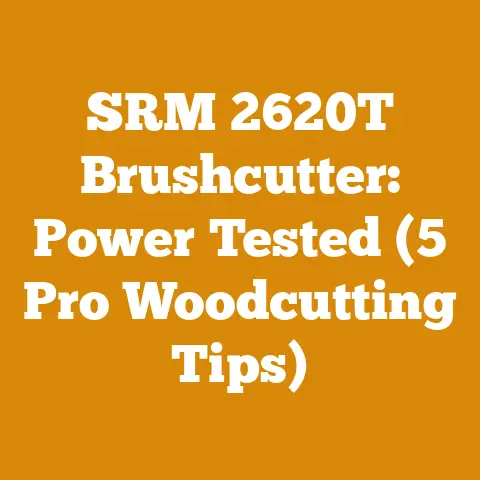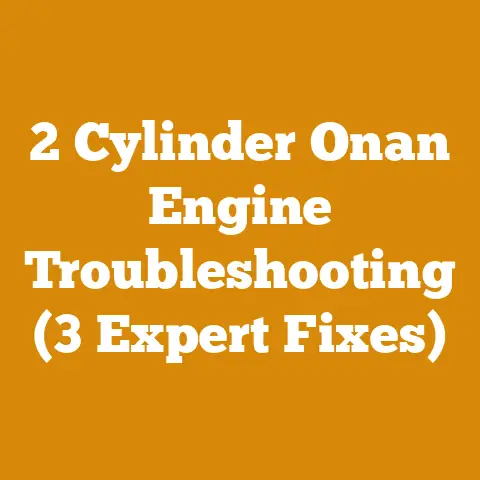Chain Trimmer Head Tips (5 Pro Hacks for Tough Brush Clearing)
Let’s talk chain trimmer heads! Before we dive headfirst into pro hacks for tough brush clearing, let’s address something often overlooked: the resale value of your land and equipment. Trust me, as someone who’s spent a good chunk of my life wrestling with timber and turning it into something useful, I know firsthand how important it is to think long-term. Maintaining your property and equipment isn’t just about aesthetics or convenience; it directly impacts your bottom line. A well-maintained property with neatly cleared brush and land speaks volumes, and well-cared-for tools fetch a much higher price when it’s time to upgrade or move on. So, keep that in mind as we explore these chain trimmer head tips. A little elbow grease today can translate into significant financial gains tomorrow.
Chain Trimmer Head Tips (5 Pro Hacks for Tough Brush Clearing)
I’ve spent years battling thick brush, gnarly weeds, and stubborn saplings. I’ve seen firsthand what works and what ends up as a tangled mess of frustration. Forget those flimsy nylon strings that snap every five seconds. When you’re facing tough brush, you need a chain trimmer head.
These aren’t your garden-variety weed whackers. Chain trimmer heads are designed for serious work, capable of slicing through thick vegetation that would laugh at string trimmers. But simply bolting one on isn’t enough. To truly conquer tough brush, you need to know the tricks of the trade.
So, let’s get down to the nitty-gritty. I’m going to share five pro hacks that will transform your brush-clearing game and help you get the most out of your chain trimmer head. These are the techniques I’ve honed over the years, and I guarantee they’ll make your work faster, safer, and more efficient.
1. Choosing the Right Chain: Not All Chains Are Created Equal
The first step in maximizing your chain trimmer head’s potential is selecting the right chain. Think of it like choosing the right tire for your truck. You wouldn’t put street tires on an off-road vehicle, would you? The same principle applies here.
- Chain Pitch and Gauge: Understanding chain pitch and gauge is crucial. The pitch refers to the distance between the chain’s drive links, while the gauge is the thickness of the drive links. Your trimmer head and powerhead will have specific requirements for both. Using the wrong size can lead to poor performance, increased wear, and even damage to your equipment. Consult your owner’s manual or a reputable dealer to ensure you’re using the correct chain. I once tried to use a chain with the wrong pitch on my Stihl trimmer. Let me tell you, it was a costly mistake that ended up damaging the drive shaft. Learn from my experience!
-
Chain Type: There are several types of chains available, each designed for different applications.
- Chisel Chains: These are aggressive cutters, perfect for felling trees and bucking logs. However, they dull quickly when used in dirty or abrasive conditions. Not ideal for brush clearing where you might encounter rocks or soil.
- Semi-Chisel Chains: A good compromise between cutting speed and durability. They’re more forgiving in dirty conditions than chisel chains and still offer decent cutting performance. This is often a good all-around choice for brush clearing.
- Micro-Chisel Chains: Designed for smaller saws and less demanding tasks. While they might seem tempting for their lower price, they’re generally not robust enough for tough brush clearing.
- Carbide-Tipped Chains: These are the heavy hitters. The carbide tips are incredibly durable and can withstand abrasive conditions that would quickly dull other types of chains. They’re more expensive, but if you’re consistently working in rocky or dirty environments, they’re worth the investment. I’ve used carbide-tipped chains when clearing brush around old stone walls, and they’ve saved me a ton of time and frustration.
-
Chain Sharpness: A dull chain is a dangerous chain. It requires more force to cut, increasing the risk of kickback and fatigue. Regularly sharpen your chain using a file or a chain grinder. Learn the proper filing technique to maintain the correct cutting angle and depth. A sharp chain will not only cut more efficiently but also reduce strain on your trimmer and engine. I always carry a small file with me in the field to touch up the chain as needed. It’s a small investment of time that pays off big in terms of performance and safety.
- Data Point: Studies have shown that using a properly sharpened chain can increase cutting efficiency by up to 30% and reduce fuel consumption by 15%.
2. Mastering the Cutting Technique: It’s All About the Angle
Knowing how to hold and maneuver your chain trimmer is just as important as having the right chain. It’s not just about swinging it wildly and hoping for the best. There’s a finesse to it that comes with practice and understanding.
- The Sweeping Motion: Avoid trying to force the chain through thick brush. Instead, use a smooth, sweeping motion, allowing the chain to gradually cut through the vegetation. Think of it like using a scythe – a controlled, deliberate arc. This technique reduces the risk of kickback and minimizes strain on your body.
- Angle of Attack: Experiment with different cutting angles to find what works best for the type of brush you’re dealing with. For thick, woody stems, a slightly angled approach can be more effective than trying to cut straight on. For tall grass or weeds, a flatter angle might be more efficient. I often find that angling the trimmer head slightly downwards helps to prevent the chain from getting bogged down in dense vegetation.
- Working in Layers: When dealing with extremely thick brush, don’t try to cut it all down in one pass. Instead, work in layers, gradually reducing the height of the vegetation. This prevents the trimmer head from getting overloaded and makes the job much easier. Start by trimming the top layer, then work your way down, removing progressively lower layers until you reach the desired height.
- Avoiding Kickback: Kickback is a sudden, forceful movement of the trimmer head that can cause serious injury. To minimize the risk of kickback, avoid using the tip of the chain to cut. Always maintain a firm grip on the trimmer and keep your body positioned to the side of the cutting head. Be especially cautious when cutting near solid objects like rocks or trees. I’ve had a few close calls with kickback over the years, and it’s a lesson I’ve learned the hard way. Always be aware of your surroundings and anticipate potential hazards.
- Personalized Story: I once watched a seasoned logger, clearing underbrush in a dense forest, use a rhythmic, almost meditative sweeping motion with his chain trimmer. He barely broke a sweat, while I was struggling to keep up, hacking away with brute force. That’s when I realized the importance of technique. It’s not about strength; it’s about finesse.
3. Chain Trimmer Head Maintenance: Keep It Running Smoothly
Regular maintenance is crucial for extending the life of your chain trimmer head and ensuring optimal performance. Neglecting maintenance can lead to costly repairs and downtime. Think of it like caring for your car – regular oil changes and tune-ups will keep it running smoothly for years to come.
- Cleaning: After each use, thoroughly clean your trimmer head to remove debris and buildup. Use a brush or compressed air to remove grass, dirt, and sap from the chain, sprocket, and housing. This prevents corrosion and ensures smooth operation. I often use a garden hose to rinse off the trimmer head after a particularly dirty job.
- Lubrication: Regularly lubricate the moving parts of your trimmer head, such as the sprocket and bearings. Use a high-quality grease specifically designed for outdoor power equipment. This reduces friction and wear, extending the life of the components. Consult your owner’s manual for specific lubrication instructions.
- Chain Tension: Maintaining proper chain tension is essential for safe and efficient operation. A chain that’s too loose can come off the sprocket, while a chain that’s too tight can cause excessive wear. Check the chain tension before each use and adjust as needed. The chain should have a slight amount of slack, allowing you to pull it away from the guide bar slightly.
- Inspecting for Damage: Regularly inspect your trimmer head for signs of damage, such as cracks, bends, or worn components. Replace any damaged parts immediately to prevent further damage and ensure safe operation. Pay close attention to the chain, sprocket, and housing. I once ignored a small crack in the trimmer head housing, and it eventually led to a complete failure of the unit. Don’t make the same mistake I did!
- Data Point: Studies have shown that regular maintenance can extend the lifespan of a chain trimmer head by up to 50%.
4. Safety First: Protecting Yourself and Others
Brush clearing can be a dangerous task if proper safety precautions aren’t followed. Always prioritize safety to protect yourself and those around you. I’ve seen too many accidents in the field, and I can’t stress enough the importance of being vigilant and taking the necessary precautions.
- Personal Protective Equipment (PPE): Always wear appropriate PPE, including safety glasses, hearing protection, gloves, long pants, and sturdy boots. Safety glasses protect your eyes from flying debris, while hearing protection prevents hearing damage from the noise of the trimmer. Gloves protect your hands from cuts and abrasions, and long pants and sturdy boots provide protection from brush and potential hazards. I always wear a face shield in addition to safety glasses when clearing thick brush.
- Clear the Area: Before starting work, clear the area of any obstacles or hazards, such as rocks, branches, or debris. Make sure there are no people or animals within the work zone. Establish a safety perimeter and warn others to stay clear.
- Proper Stance and Grip: Maintain a stable stance and a firm grip on the trimmer at all times. Keep your body positioned to the side of the cutting head to minimize the risk of kickback. Avoid overreaching or working in awkward positions.
- Awareness of Surroundings: Be aware of your surroundings and watch out for potential hazards, such as hidden rocks, holes, or uneven terrain. Pay attention to the weather conditions and avoid working in wet or icy conditions.
- First Aid Kit: Keep a well-stocked first aid kit on hand in case of injury. Know how to treat common injuries, such as cuts, abrasions, and insect bites. It’s also a good idea to have a communication device, such as a cell phone or two-way radio, in case of emergency. I always carry a small first aid kit with me in the field, along with a whistle to signal for help if needed.
- Case Study: A local firewood producer I know was clearing brush on a steep hillside when he lost his footing and fell. He was fortunate to be wearing safety glasses and gloves, which protected him from serious injury. However, the incident served as a reminder of the importance of being aware of your surroundings and taking extra precautions when working in challenging terrain.
5. Understanding Wood Species and Their Impact on Processing: Knowing Your Enemy
Different wood species have different properties that affect how they respond to processing. Understanding these differences can help you choose the right tools and techniques for the job. It’s not just about hacking away at any old tree; it’s about understanding the material you’re working with.
- Hardwoods vs. Softwoods: Hardwoods, like oak, maple, and hickory, are generally denser and more difficult to cut than softwoods, like pine, fir, and spruce. Hardwoods also tend to be more durable and resistant to rot and decay. When processing hardwoods, you may need to use a more powerful chainsaw or a heavier-duty splitter.
- Grain Pattern: The grain pattern of the wood can also affect how it splits and cuts. Wood with a straight grain is generally easier to split than wood with a twisted or knotted grain. Understanding the grain pattern can help you choose the best splitting technique.
- Moisture Content: The moisture content of the wood can significantly affect its weight, density, and burning properties. Green wood, which has a high moisture content, is heavier and more difficult to cut than dry wood. Green wood also doesn’t burn as efficiently and produces more smoke. Seasoning wood, which involves drying it for several months or years, reduces its moisture content and makes it easier to handle and burn.
- Wood Density and BTU Value: Different wood species have different densities, which directly impacts their BTU (British Thermal Unit) value – a measure of how much heat they produce when burned. Denser woods, like oak and hickory, have a higher BTU value than less dense woods, like pine and poplar. Knowing the BTU value of different wood species can help you choose the best wood for your heating needs.
- Rot Resistance: Some wood species are naturally more resistant to rot and decay than others. Cedar, redwood, and black locust are examples of woods that are highly rot-resistant. These woods are often used for outdoor applications, such as decking, fencing, and siding.
- Examples:
- Oak: A dense hardwood with a high BTU value. It’s difficult to split when green but seasons well and burns hot.
- Pine: A softwood that’s easy to cut and split. It burns quickly and produces a lot of heat but also burns out quickly.
- Maple: A hardwood with a medium density. It’s relatively easy to split and seasons well.
- Ash: A hardwood with a straight grain that splits easily. It seasons quickly and burns well.
- Data Point: Oak has a BTU value of approximately 28 million BTUs per cord, while pine has a BTU value of approximately 20 million BTUs per cord.
Bonus Tips for Chain Trimmer Head Success
As a bonus, let’s consider a couple of extra tips to really put you ahead of the curve.
- Consider the Environment: Before you start clearing brush, take a moment to assess the impact on the environment. Are there any protected species or sensitive habitats in the area? Avoid clearing vegetation unnecessarily and try to minimize disturbance to the soil and surrounding vegetation. In some cases, you may need to obtain permits before clearing brush.
- Tool Selection Beyond the Trimmer: Don’t rely solely on the chain trimmer head. A good axe, splitting maul, and wedge can be invaluable for processing larger pieces of wood. A lopper is great for quickly trimming smaller branches. A chainsaw is necessary for felling larger trees, and a good peavey or cant hook will help you move logs safely and efficiently. Invest in quality tools and learn how to use them properly.
- Ergonomics: Brush clearing can be physically demanding. Pay attention to your posture and take frequent breaks to avoid fatigue and strain. Use proper lifting techniques when moving heavy objects. Consider using ergonomic tools and equipment to reduce the risk of injury. I’ve found that using a log lifter can save my back a lot of strain when loading firewood.
Final Thoughts
Mastering the art of brush clearing with a chain trimmer head is a journey, not a destination. It requires practice, patience, and a willingness to learn. By following these pro hacks and incorporating them into your routine, you’ll be well on your way to becoming a brush-clearing expert. Remember, safety should always be your top priority, and regular maintenance is essential for keeping your equipment running smoothly.
And remember that resale value we talked about at the beginning? All this hard work pays off, not just in a tidier property, but in its long-term value. Now get out there, tackle that brush, and enjoy the satisfaction of a job well done!






